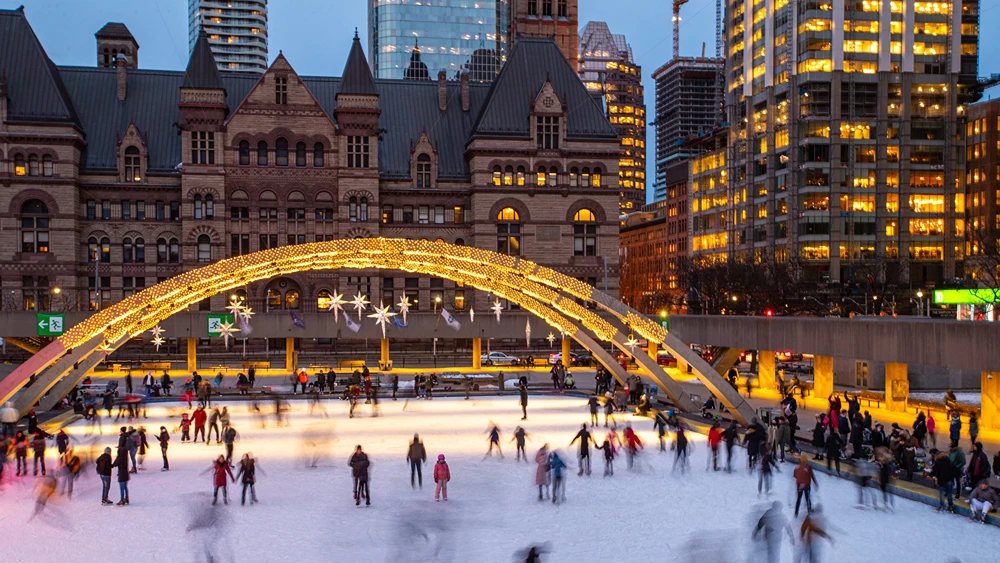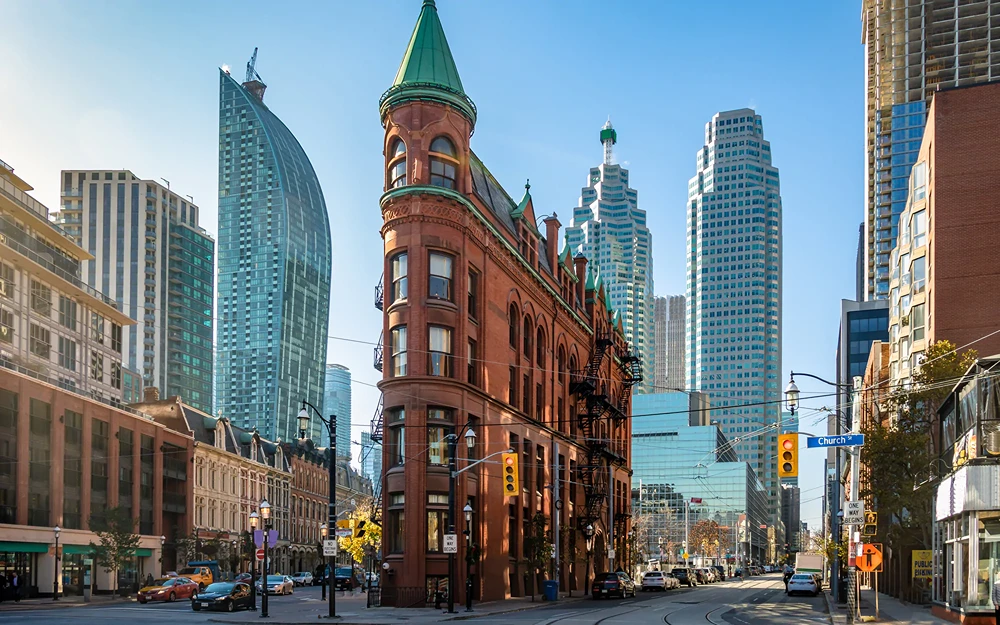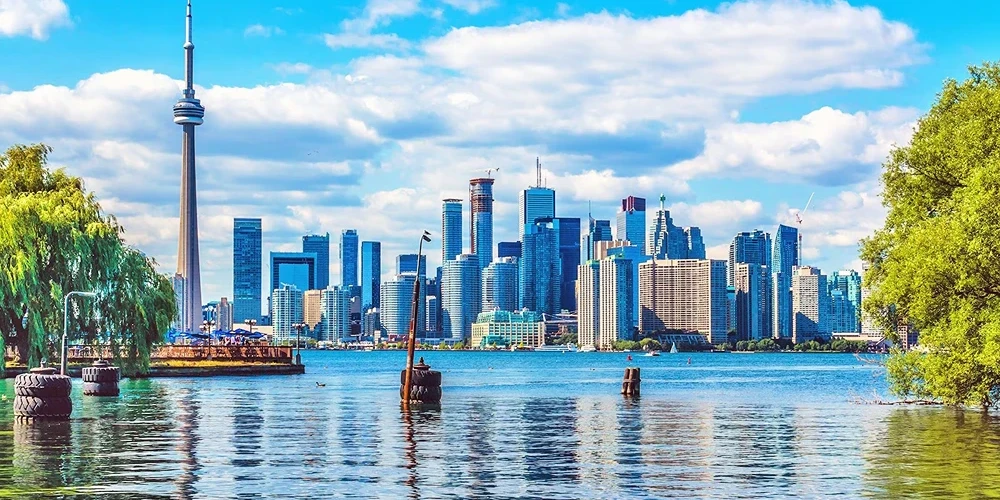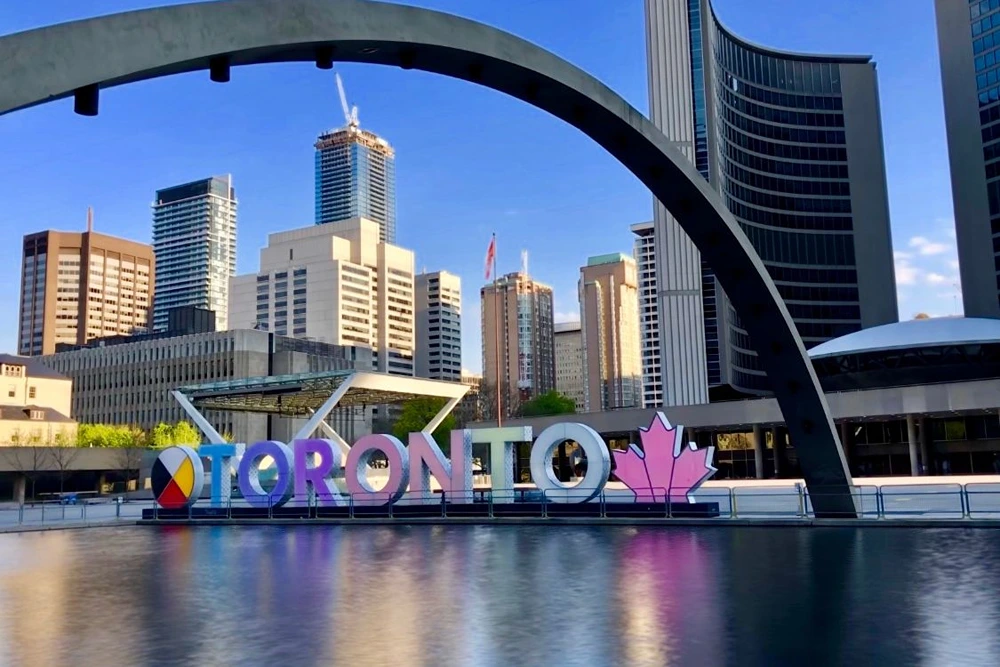Key Highlights:
- Location: Situated on the northwestern shore of Lake Ontario
- Population: Approximately 2.7 million in the city, over 6 million in the Greater Toronto Area
- Languages: English is the primary language, but over 180 languages are spoken in the city
- Nickname: “The Six,” popularized by Toronto-born rapper Drake
Toronto is Canada’s largest city and a global center for business, finance, arts, and culture, offering visitors an exciting blend of experiences from high-end shopping to diverse culinary adventures.
Travel Resources
To help you plan your perfect trip to Toronto, here are some essential resources:
- Flights: Find affordable flights to Toronto Pearson International Airport (YYZ) using our flight comparison tools.
- Insurance: Secure comprehensive travel insurance to protect against unexpected events.
- Car Rental: Book a rental car for flexibility in exploring Toronto and its surrounding areas.
- Tours: Discover guided tours showcasing Toronto’s diverse neighborhoods, cultural landmarks, and hidden gems.
- Packing: Use our Toronto-specific packing checklist to ensure you’re prepared for the city’s variable weather and activities.

Some History First
Toronto’s history is a fascinating journey from indigenous settlement to global metropolis.
Key Historical Points:
- Pre-colonial era: Home to various indigenous peoples, including the Huron-Wendat and Haudenosaunee
- 1787: Toronto Purchase agreement between the British Crown and the Mississaugas of the Credit First Nation
- 1793: Town of York established (later to become Toronto)
- 1834: City of Toronto incorporated
- 1954: Toronto Transit Commission (TTC) opens Canada’s first subway line
- 1967: Toronto City Hall opens, becoming an iconic symbol of the city
- 1976: CN Tower completed, then the world’s tallest freestanding structure
Today, Toronto continues to evolve as one of North America’s most dynamic and diverse cities.
Toronto Today
Modern Toronto is a thriving metropolis that embraces its multicultural identity and status as a global city.
Notable Aspects of Contemporary Toronto:
- Cultural Mosaic: Home to numerous ethnic enclaves like Little Italy, Chinatown, and Greektown
- Financial Hub: Houses the Toronto Stock Exchange and headquarters of Canada’s major banks
- Entertainment Capital: Hosts the Toronto International Film Festival (TIFF) and numerous cultural events
- Education Center: Home to world-renowned institutions like the University of Toronto
- Sports City: Major league teams include the Maple Leafs (NHL), Raptors (NBA), and Blue Jays (MLB)
Is Toronto Safe?
Toronto is generally considered one of the safest large cities in North America, with a relatively low crime rate.
Safety Tips:
- Exercise normal precautions as you would in any urban environment
- Be aware of pickpocketing in busy tourist areas and on public transportation
- Use caution when walking alone at night in less populated areas
- Be mindful of bicycle lanes when crossing streets
- In winter, watch for icy sidewalks and falling ice from tall buildings
Emergency Services: Dial 911 for police, fire, or medical emergencies
Where is Toronto?
Toronto is strategically located in Southern Ontario, offering easy access to both urban amenities and natural attractions.
Geographical Details:
- Coordinates: 43°42′N 79°20′W
- Area:2 km² (243.3 sq mi)
- Terrain: Mostly flat or gentle hills, with many ravines and river valleys
Nearby Attractions:
- Niagara Falls: About 1.5 hours southwest
- Algonquin Provincial Park: About 3 hours north
- Ottawa: About 4.5 hours east
- Thousand Islands: About 3 hours east
Latest Articles
From The Area
What is the Best Time to Visit Toronto?
Toronto experiences four distinct seasons, each offering its own unique charm and activities.
Seasonal Highlights:
- Summer (June-August):
- Pros: Warm temperatures, numerous festivals, outdoor events
- Cons: Peak tourist season, higher prices
- Fall (September-November):
- Pros: Beautiful fall colors, mild temperatures, film festival season
- Cons: Increasing chance of rain, some outdoor attractions may close
- Winter (December-February):
- Pros: Winter sports, festive holiday atmosphere, indoor cultural events
- Cons: Cold temperatures, snow, and ice can affect travel
- Spring (March-May):
- Pros: Blooming gardens, warming temperatures, fewer crowds
- Cons: Possibility of late snow, some attractions may have limited hours
Best Time to Visit: For most travelers, late spring to early fall (May to September) offers the best balance of pleasant weather and abundant activities.
How to Get to Toronto & Around
Toronto is well-connected and easy to navigate, whether you’re arriving from abroad or exploring the city itself.
Getting to Toronto:
- By Air: Toronto Pearson International Airport (YYZ) is Canada’s busiest airport, serving numerous domestic and international flights
- By Train: VIA Rail and GO Transit provide service to Toronto from other Canadian cities
- By Bus: Several bus companies offer services to Toronto from various North American cities
- By Car: Major highways connect Toronto to other parts of Canada and the USA
Getting Around Toronto:
- Public Transit: The Toronto Transit Commission (TTC) operates an extensive network of subways, streetcars, and buses
- Biking: Toronto has an expanding network of bike lanes and a bike-share program
- Walking: Many attractions in the downtown core are within walking distance
- Taxis and Ride-sharing: Readily available throughout the city
Tip: Consider purchasing a PRESTO card for easy use of public transportation in Toronto and surrounding areas.
Things to Do in Toronto
Toronto offers a wide array of attractions and activities for visitors of all interests.
Must-Visit Attractions:
- CN Tower: Iconic landmark offering panoramic views of the city
- Royal Ontario Museum (ROM): Canada’s largest museum of world cultures and natural history
- Art Gallery of Ontario (AGO): One of the largest art museums in North America
- Ripley’s Aquarium of Canada: Home to over 16,000 aquatic animals
- Toronto Islands: A chain of small islands offering beaches, parks, and great city views
Cultural Experiences:
- Distillery District: Historic area with Victorian architecture, boutiques, and galleries
- Kensington Market: Eclectic neighborhood known for its diverse shops and food scene
- Lawrence Market: Historic market complex, great for food lovers
- Hockey Hall of Fame: Celebrating the history of ice hockey
Outdoor Activities:
- High Park: Toronto’s largest public park with hiking trails, gardens, and a zoo
- Edwards Gardens: Beautiful botanical gardens
- Toronto Waterfront Trail: Perfect for walking, jogging, or cycling along Lake Ontario
Where To Stay In Toronto
Toronto offers a wide range of accommodations to suit every budget and preference.
Popular Areas to Stay:
- Downtown: Ideal for first-time visitors, close to many attractions
- Yorkville: Upscale neighborhood known for luxury hotels and high-end shopping
- Queen West: Trendy area with boutique hotels and a vibrant arts scene
- Harbourfront: Great for waterfront views and proximity to attractions
Accommodation Types:
- Luxury hotels
- Boutique hotels
- Budget-friendly hostels
- Vacation rentals
- Bed and breakfasts
Tip: Book in advance if visiting during peak summer months or major events like the Toronto International Film Festival.

What To Eat In Toronto
Toronto’s culinary scene reflects its multicultural population, offering a diverse range of cuisines and dining experiences.
Must-Try Local Specialties:
- Peameal Bacon Sandwich: A Toronto classic, best tried at St. Lawrence Market
- Poutine: French fries topped with gravy and cheese curds
- Toronto-style Pizza: Unique style with a thin crust and gourmet toppings
- Multicultural Cuisines: Authentic dishes from around the world in various ethnic neighborhoods
- Craft Beer: Toronto has a thriving craft brewery scene
Notable Dining Areas:
- King West: Trendy restaurants and bars
- Ossington Avenue: Hip dining scene with innovative restaurants
- Danforth Avenue (Greektown): Great for Greek cuisine
- Chinatown and Kensington Market: Diverse international options
Tip: Don’t miss trying some Canadian classics like butter tarts and Nanaimo bars for dessert.
Entry & Exit Requirements
Visitors to Toronto must comply with Canadian immigration regulations.
Key Requirements:
- Valid Passport: Required for all international visitors
- eTA or Visa: Electronic Travel Authorization (eTA) required for visa-exempt foreign nationals flying to Canada. Others may need a visitor visa.
- Length of Stay: Typically up to 6 months for tourists
- Proof of Funds: May be required to show you can support yourself during your stay
- Return Ticket: May be asked to show proof of intention to leave Canada
Note: Requirements can change. Always check the official Government of Canada website for the most up-to-date information.
What To Pack For Your Trip
Toronto’s weather can vary greatly depending on the season, so packing adaptable clothing is key.
Essential Items:
- Layered Clothing: Temperatures can fluctuate, especially in spring and fall
- Comfortable Walking Shoes: Toronto is a great city to explore on foot
- Winter Gear: If visiting in colder months, pack a warm coat, gloves, hat, and boots
- Rain Jacket or Umbrella: Weather can be unpredictable
- Swimwear: For beaches or hotel pools
- Dress Clothes: For fine dining or attending cultural events
- Reusable Water Bottle: Toronto tap water is safe to drink
Tip: If visiting in winter, bring ice grips for your shoes to navigate icy sidewalks safely.
Remember to check current local guidelines and restrictions before your trip, as they may affect your travel plans and experiences in Toronto.
FAQs
Check the Government of Canada’s official website to determine if you need a visa based on your nationality.
Explore diverse neighborhoods like Kensington Market, The Annex, and Little Italy for unique experiences and local charm.
Yes, Toronto has an efficient public transit system (TTC) that makes it easy to navigate the city without a car.



